Climate, Planning, Economy. Tips 81+
0↓
Contents #81
- #81: No cars in the city
- #82: Friends, neighbours and architectural determinism
- #83: No more high buildings
- #84: Oscar Newman: Look, learn and improve
- #85: Five planning policies
- #86: Cheap, neighbourly and doesn’t screw the world up
- #87: Needed: Enhanced town planning
- #88: A new Ministry of Works
- #89: Cut methane emissions now
- #90: Cumulative climate damage
Goto 1 11 21 31 41 51 61 71 81 91
↑#81: No cars in the city
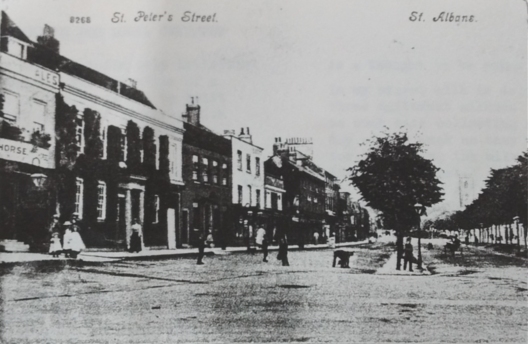
Once upon a time children played in the streets outside their houses, cycling clubs would go out for a spin in the country at the weekend and people would walk around or stop and talk in the city centre streets or their local high street. Now traffic has taken most of the space that was used for these activities. It has, in fact, completely taken over the major supply of easily accessible communal land – the public highway.
It is this gradual and largely unnoticed take-over of this public space that has hidden one of the main disadvantages to mass car transport: the large amount of space required.
Modern town planners are now setting aside areas which can hold the activities displaced by the car: 0n the housing estates they are providing ‘minor open space’; in suburban areas they are providing playing fields and parks; in the city: the shopping precinct.
But today’s ‘minor open space’ isn’t quite the same as the street before mass car use. It is often the land left over after houses and roads have been put on the plans. It becomes a self-consciousness, unnatural space which fails to develop the rich activity pattern of the old-fashioned street. These communual ‘spaces’ are less easily accessible than the car-less streets that were once safe to play and meet on.
The article No cars in the city discusses more of the problems of cars in cities.
↑#82: Friends, neighbours and architectural determinism
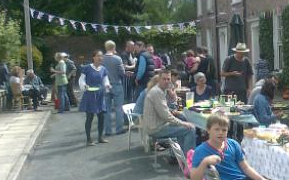
Much of the brutalist public housing built in the 1970s has been demolished.
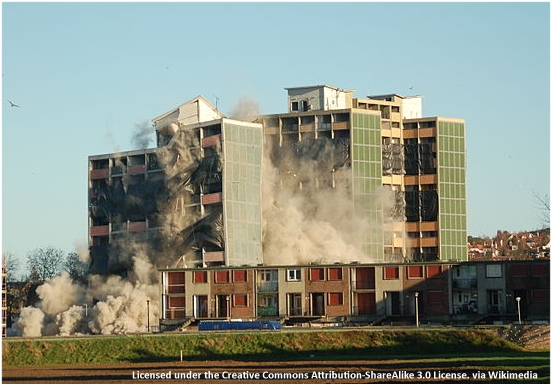
Their failure has even reached the main stream media, such as the story in The Express, Stop families being herded into high rise, crime ridden tower blocks.
‘Archtectural determinism’ covers a range of beliefs about how architectural surroundings can change behaviour – and to what extent.
The article Friends, neighbours and architectural determinism discusses some of the theoretical approaches that have been put forward.
↑ #83: No more high buildings
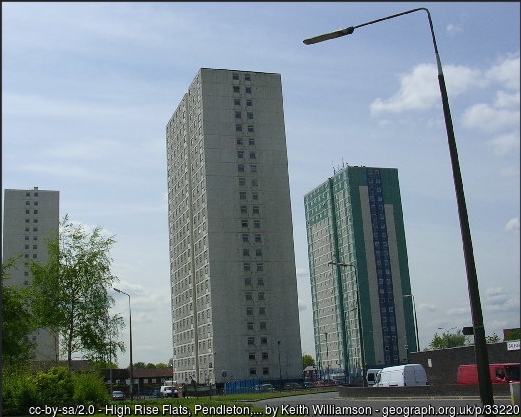
Several building methods are suitable for high buildings: steel frame and steel reinforced concrete. Their construction has a negative impact on the environment, which increases with height. As noted in Part 1: Embodied carbon and climate, large emissions of greenhouse gasses are leading us to climate disaster. This means, we should build very few new high buildings – unless a switch to building tall buildings in wood is possible.
The higher the building,whether wooden, steel or concrete, the more complicated the design and maintenance. Lifts, rubbish chutes, external stairs and safety barriers are needed. Tall buildings require better water proofing, sound & heat insulation and a higher level of structural and fire safety. There is much more to go wrong. Designing high buildings requires a high level of design skills.
Requiring better design – and better maintenance – increases cost. When high buildings go wrong solutions are difficult or impossible as with Ronan Point (structure), Hunslet Grange (damp & policing) or Grenfell Tower (fire)
The article Friends, neighbours and architectural determinism discusses the social difficulties.
↑#84: Oscar Newman: Look, learn an improve
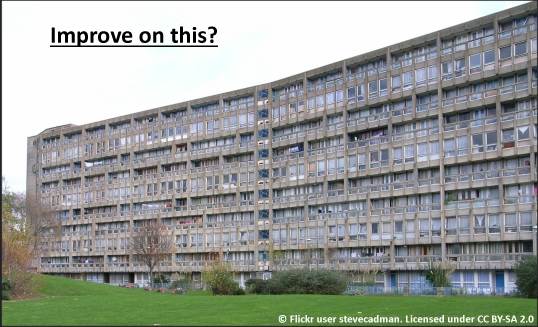
Robin Hood Gardens: [Andy Burnham’s] ministerial decision endorsed the recommendation of English Heritage that Robin Hood Gardens “fails as a place for human beings to live” and did not deserve statutory heritage protection.
When Oscar Newman visited Leeds School of Architecture in 1976, I asked him how the students could go about designing better housing. I can’t give an exact quote but, as I remember, he said to look for the best housing you can find and design something 5% better. Basically: ‘look, learn and improve’.
I was shocked that an architect, who had proposed high profile theories of human interaction in housing should say something so lacking in theory: his book, Defensible Space; Crime Prevention Through Urban Design, makes predictions of how people interact depending on the architecture they live in. I had expected an answer involving spatial principles for the layout of housing and the connections between them: Principles on which designs could be constructed.
The article Look, learn and improve discusses how over theoretical approaches to housing failed by looking at the evidence.
↑ #85: Five planning polices
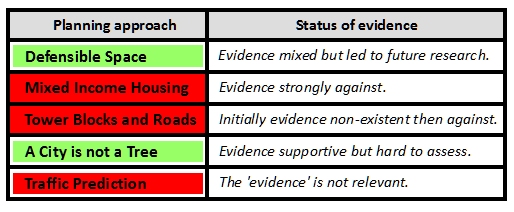
These results show that an Institute of Enhanced Town Planning is urgently needed.
↑ #86: Cheap, neighbourly and doesn’t screw the world up
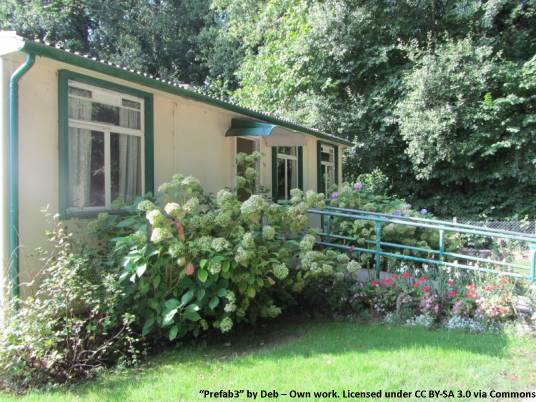
- Cheap, neighbourly and doesn’t screw the world up
- Prefabs are for people
- An example of properly low carbon housing
- A sustainable prize winner? Goldsmith Street
For cheap and green housing, these must be eliminated or minimised:
- High buildings (#83)
- Cars (#81)
- Greenbelts and restrictive planning (#79)
- Conventional construction (#75)
- Industrialised farming (#76)
Having eliminated these expensive and unsustainable alternatives, we must look at what remains?One possibility is …
Estates of car-free, wooden prefabs
with integrated market gardens
↑ #87: Needed: Enhanced town planning
- The Institute of Enhanced Town Planning
- Topics for enhanced town planning: #1 to #5
- Topics for enhanced town planning: #6 to #10
- New economies for new estates
A new form of town planning is needed, which can design and create new settlement patterns for new ways of living, which are pleasant and low carbon. Enhanced town planning should have the power to shape local economies. e.g have the power to set local taxes and subsidies.
See also
- #86: Cheap, neighbourly and doesn’t screw the world up,
- #88: A new Ministry of Works
- #93 Car free living & happy degrowth.
Government should commission prototypes to create a rich gene pool of settlement types so that the ones shown to work best can become part of our pattern book. There will be a need for criteria to judge ‘success’ but these are almost certain to change as projects progress. Here are some suggestions for parameters to be used in evaluating prototypes:
- Number of residents
- Density of settlement
- Local cost of living
- % of residents employed locally
- % of food produced locally
- % of goods bought from local retailers
- % of goods made by local residents
- Social class of the residents.
- Weekly travel distances.
- Energy and water use
- Carbon footprints of residents
- Protection of ecosystems
- Happiness of residents
- A measure of neighbourliness
These proposed housing settlements can be examined as separate local economies that trade with the outside and have a locally measured ‘GDP’.
↑ #88: A new Ministry of Works
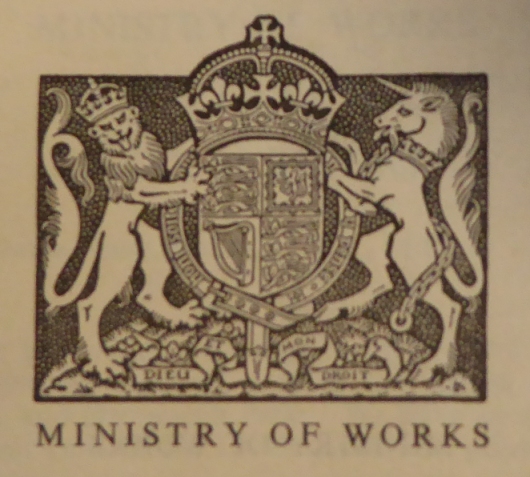
We need a new Ministry of Works, with the brief to create new settlements that are cheap, green and friendly. The aim is to find ways of life that are pleasant and won’t screw the world up. One example would be estates of car-free, wooden prefabs with inbuilt market gardens built around transport hubs, with localised economies – created using an enhanced form of town planning .
The New Ministry of Works will take over many of the responsibilities of existing government departments. These departments form a complex system of regulation and control. Experience tells us that changing any complex system must be taken with care. Experience in the development of complex software systems can be used as an analogue.
From Wikipedia:
The Ministry of Works was a department of the UK Government formed in 1940, during World War II, to organise the requisitioning of property for wartime use. After the war, the Ministry retained responsibility for Government building projects.
https://en.wikipedia.org/wiki/Ministry_of_Works_(United_Kingdom)
A new Ministry of Works, should be given wide ranging powers, to develop new ways of life that are pleasant and do not ruin the climate. Perhaps politics means the requisitioning of property is undesirable but in challenging the monopolistic market in land, the use of compulsory purchase should be available.
The Ministry of Works oversaw the building of temporary housing, prefabs. Many turned out to be much more popular than planners anticipated:
In days of lockdown we might compare a prefab with a garden to a multistorey block, which might have balconies. Briefly:
- People liked prefabs
- Multistorey mass housing failed
- The planners didn’t notice
- They will get it wrong again
↑ #89: Cut methane emissions now
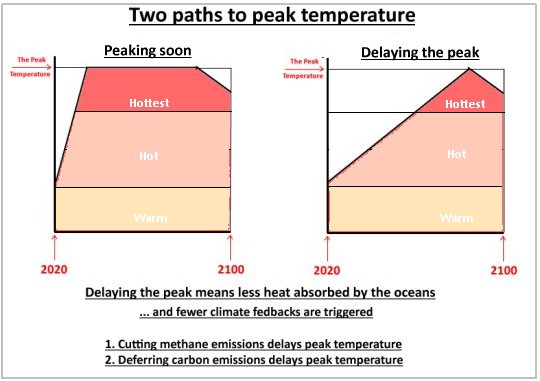
Recently, I have found a sources which claims that stopping methane emissions would cause a fall in Earth’s surface temperature of 0.62°C.
Because the Earth is within 0.5 °C of the target limit of the Paris Agreement, the obvious question is “Why don’t we do it?” and stop the fossil fuel industry leaking it, give up beef and lamb consumption and put some international pressure to curtail emissions from rice production in paddy fields. So, let’s start
- No beef
- No dairy
- No fracking
- No rice from paddy fields
↑ #90: Cumulative climate damage
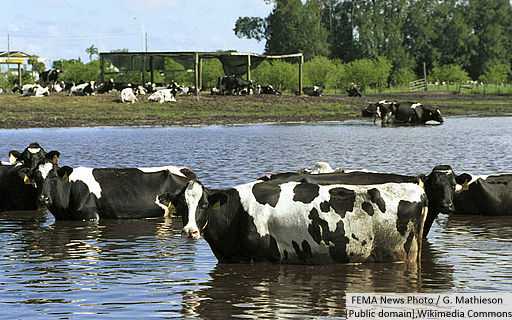
- Cheating with temperature
- Instant Earth & Cumulative Earth.
- The CCC should advise the Government that …
The Paris Agreement aimed to curb greenhouse gas emissions so that Earth’s mean surface temperature (GMST) does not rise more than 2°C above pre-industrial temperatures. Even more, it aimed at keeping the rise to 1.5°C . It is an agreement with a target of a maximum temperature, which should not be exceeded in any one year.
What it does not address is the effects of continuous heating over decades, which cumulatively stores heat in the Earth, causing effects like sea level rise and ice sheet collapse. A target of a maximum surface temperature downplays the feedback effects, which accelerate climate change, such as greenhouse emissions from melting permafrost or the change in the way radiation is reflected away from the Earth.
A maximum temperature does not define the state of the Earth: There may be more or less greenhouse heat stored in the ocean. More or less glacier ice may have disappeared. More or less tundra may have thawed. The Paris Agreement does not account for these.
These considerations are relevant to emissions of short lived greenhouse gases, particularly methane. Its effect on surface temperature dissipates after a few decades, due to chemical decomposition. However, most of the greenhouse heat from its stay in the atmosphere is still stored below the Earth’s surface, mostly as ocean heat content, causing sea-level rise and climate feedbacks.
TrackBack URL :
